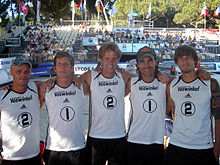Footvolley
Footvolley is a trend sport from Brazil that combines beach volleyball and soccer . It requires excellent technique, coordination and body control in the sand. The rallies are often longer than in beach volleyball and are considered spectacular for the audience.
regulate
The rules of footvolley are based on those of beach volleyball. Two teams with two players each face each other on a beach volleyball field (16 m × 8 m; 8 m × 8 m per field), which is divided by a 2.20 m high net (women: 2.10 m). The substrate should be filled with fine quartz sand (0.1–0.7 mm grain size), free of stones and a minimum height of 35 cm.
The aim of the game is to bring the ball correctly over the net onto the floor of the opposing half of the field and to prevent it from falling to the ground in your own half of the field. As in football, the ball must not be touched with the arms or hands, which is why more active people from this sport come to footvolley than from beach volleyball. The ball is put into play by a player lifting it over the net from a mound of sand no more than a meter behind the baseline. At the latest with the third contact, the ball must be played over the net without touching it. If this does not succeed, the opponent receives one point. Two sets of wins are played. To win a set you need 18 points with at least two points ahead, which are counted according to the rally point system. A sentence is limited to a maximum of 21 points.
history
Footvolley ( futevolei ) originated on the beaches of Brazil in the 1960s. In Rio de Janeiro , footballers prevented the police from banning their game by using the beach volleyball fields. Prominent footballers such as Romário , Bebeto , Zico , Ronaldo or Ronaldinho , who practiced the trend sport in their free time, contributed to making it more and more famous and popular.
Footvolley came to Europe in the 1990s, where the European Footvolley Federation (EFVF) was founded in November 2003. At the same time, the sport was included in the German Beach Soccer Association (DBSV) and since 2007 it has been running independently under "Footvolley Germany". In 2004 the German Footvolley Association (DFVV) emerged as a national competitor and belongs to the FIFV (Federation International of Footvolley). In Austria there are also two associations: the footvolley association ÖFV and the Austrian Football Federation (AFF), while the Swiss players are organized in the Swiss Football Association (SFVV).
At the 2016 Olympic Games in Rio de Janeiro , footvolley was played as a demonstration sport .
Footvolley in Germany
Since 2004, Footvolley Germany (since 12/2007 the German Footvolley Association) has held international tournaments in Germany. The German ranking is played every year at five locations in Germany in winter. The top teams represent Germany both at the official European championship of the European association EFVL and at other European and international tournaments. In 2016 the European Championships took place in Germany. There are now clubs in many locations in Germany that officially run footvolley as a department and offer regular training and games.
Web links
- German Footvolley Association eV (German National Team)
- European Footvolley Federation (EFVL) (English)
- Austrian Footvolley Association
Individual evidence
- ↑ http://www.footvolley.de/rechte/
- ^ It's a cross between beach volleyball and soccer, and it's debuting at the Olympics. The Miami Herald , July 18, 2016, accessed July 21, 2016 .
- ↑ About EFVL. Retrieved February 18, 2019 (UK English).
- ^ Organization - Footvolley Germany. Retrieved on February 18, 2019 (German).


